by
The Critical Tourist
Does a high-profile controversy or a scandal around a work of art blemish the artist for life? Is it ever possible to discuss her other projects without reference to that particular incident, or is every mark she makes forever destined to be judged by it? Or worse, does the dispute’s gravity justifies boycotting the artist altogether? Such questions nagged me as I walked through the solo exhibition of Dana Schutz’s paintings at Boston’s Institute of Contemporary Art (July 26-November 26, 2017). A specific painting by Schutz, exhibited at the Whitney Biennial earlier this year, triggered overwhelming protests and counter-protests from various circles within the American art-culture world; issues concerning cultural appropriation and ownership of iconic images raged against the ugly backdrop of American race relations. My attempt to come to terms with the above questions, especially in light of the petition launched to have the ICA show canceled (even though the disputed image was not among the exhibits), is the reason this review is slightly belated. Having pondered the questions sufficiently in the backdrop of that raucous debate, where I feel most voices had certain legitimate claims, I eventually concluded that I should treat the Whitney image and the controversy around it in a separate essay devoted to the subject of appropriation, with Schutz’s case as a key instance. Here, on the other hand, my attention remains focused exclusively on the exhibits at the ICA show.
“Existential theater” is the term that insistently follows me around as I peruse the several paintings and large charcoal drawings produced roughly over the last decade. And I don’t mean it in a trivial, figure-of-speech sense; both words carry substantial meaning for me. The characters of Schutz’s images are almost always locked in intense encounters –either social or psychological– that seem to address aspects of the human condition. What is more, shaped by a deeply personalized version of grotesquerie combined with dark humor, the figures do not simply appear as characters, but rather in character, as if performing assigned roles in plays, with Schutz as both the playwright and the director. And far from presenting them simply as illusions of life, a range of contrasting pictorial strategies expose their roleplaying: suffocating, claustrophobic spaces alternated with occasional room to breathe; radically exaggerated portraiture of apparently mundane sitters; unusually bright palettes for subjects that would thrive in an overbearing sense of gloom, and so on. In other words, painting becomes the mediating agent separating fiction from reality. Let me clarify how these contrasts actually function in the images.
When I say “theatrical” in the context of Schutz’s work, I mean it as distinct from “drama”, and I use the term “theater” to mean a medium that specifically articulates theatricality, not drama. This distinction has long been central to much of the scholarship of the celebrated art historian and critic Michael Fried, especially in his influential study of eighteenth- and nineteenth-century French painting. Theatricality, to Fried, is frivolous and sensational, lacking the absorptive, nuanced character of the dramatic.[i] I, however, do not see this difference between the dramatic and the theatrical in Schutz’s work in hierarchical terms; rather, I find in it an unfolding of the folly and fragility of human existence that is intriguing precisely because boisterous theatricality disrupts and displaces somber drama. The sense of foreboding that pervades many of Schutz’s images is frequently invaded by the extravagant, the absurd, and the burlesque, which turn the grotesque into comical versions of itself. What would otherwise be disturbing is often transformed into a delightfully chaotic, irrational parade of humanity. Take, for instance, the large canvas, Big Wave (2016). A giant wave rises in the background of two oblivious little girls playing on the beach (their absorption in building fragile sand castles is perhaps symbolic of civilization’s callous indifference to an environmental crisis?). If the tsunami, made all the more intimidating by the giant fish eye in the middle, is a glimpse of a frightening human predicament, it is sharply contrasted by the eccentricity of an open space behind it with an immense sun.
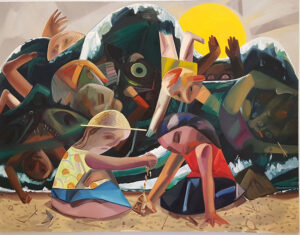
Big Wave, oil on canvas, 2016.
All of it, rendered with a vibrant palette, keeps the ominous at bay– for all I know, the mass in the middle could as well be a pile of toys –albeit an unusually large one– in a child’s room. The bracketing of the threat of destruction with the playing kids in the foreground and a child’s landscape painting of a glaring sun behind hills in the background shows how Schutz balances the gravity of an impending drama with a brilliant touch of levity. Elevator (2017), an even larger canvas, shows a variant of the same approach. Here dread is provoked not just by the claustrophobic space of the interior of an elevator overflowing with people engaged in a vicious brawl, but also by monstrous insects attacking the crowd. The intensity of the physical contact within a severely confined space is heightened by the tilt of one of the half-open elevator doors (evidence of Schutz’s compositional prowess), with the wild brushstrokes on both doors representing reflections on shiny metal surface. The crawling insects, from the relatively innocuous roach on the floor and the large ant on the amplifier of the gramophone, to the enormous red-eyed monster on the upper right and the clawed one dominating the lower middle area, simply make the scenario more threatening; they could indeed make any entomophobe considerably jittery. Yet a closer inspection exposes all the characters, including the anthropoid invaders, as more like props from a play: the anxious faces appear vacant and mask-like, and the revolting insects look all too painterly –funny, actually– to do any harm. Subtle touches, such as the man in the foreground picking up a fragment of a drawing from the floor in the middle of all the fracas, contribute to making the grotesque palatable. They dispel the initial nightmare to unveil a painted theater that is deliberately distanced from life.
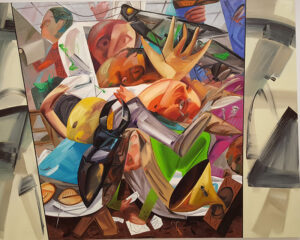
Elevator, oil on canvas, 2017.
This skillful displacement of the promise of a serious drama by making the grotesque appear more eccentric and comical than threatening is also recognizable in Schutz’s relatively smaller canvases with one or two characters, which are a break from the overwhelming array of motifs and actions that characterize the larger ones. In Crawling (2016), for instance, two men, one carrying another on his back, are invaded by an army of insects, the largest one appearing to rival the herculean carrier in size and strength. Unlike a setting appropriate for such a nightmarish scenario, however, the encounter takes place in a bright space horizontally divided into a land and a blue sky, bordered on the top by a partly visible enormous sun, much like the background
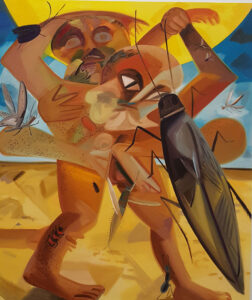
Crawling, oil on canvas, 2016.
in Big Wave. Had such incongruous juxtaposition faithfully taken the Surrealist path, it would certainly have intensified the ominous vibe of the scene. Instead, while enhancing the absurdity of the confrontation, the incongruity removes the scene from any rational reference to reality and offers it as part of an idiosyncratic painted world where bathed in light, the bizarre becomes rather playful. For instance, the staring contest between the bearded man and the monstrous insect facing him is candidly comical, as is the terror of the piggybacking man. A lively palette plays a similarly active role in As Normal as Possible (2015), an aggressively at-your-face portrait of a young girl. The intense stare from translucent, hypnotic eyes and a mysterious grin, framed under
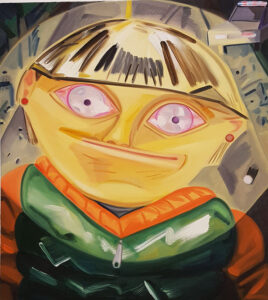
As Normal as Possible, oil on canvas, 2015.
the hood of a jacket, are enough to conjure Chucky the serial killer doll. But bright colors intervene once again to dispel that unease; what initially seems nefarious appears, upon insistent looking, merely mischievous. It is perhaps a painted exaggeration of an overenthusiastic posture in front of a camera, one of those distorted, clumsy poses for a selfie. The brightness of the face could well be read as a result of a camera flash in action. Swimming Smoking Crying (2009) employs some of the same tools, but in a much more complex interplay of form, space and color. Half-immersed in water, holding a cigarette in the mouth, an odd, balloon-like head swims sideways. The exaggerated, tearful eyes appear dazed. The water surface divides the scene into two distinct mood zones: the portion of the head under the surface all but melts into the dark abyss at the bottom, accented by the cigarette and a large tear drop, both pointing downward. Above the surface, the clarity of the head’s contour, arched by a grossly disproportionate and desperately paddling right hand, sharply contrasts its fuzzy boundaries down below, as if survival instinct struggles to win over the temptation to surrender to depression and despair. And in keeping with this opposition, the bright sky contrasts the ominous dark of the deep waters. All of this, however, seems too exaggerated,
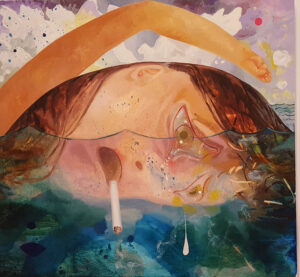
Swimming Smoking Crying, oil on canvas, 2009.
too absurd to be serious, not least because of the sheer impossibility of simultaneously acting out the way the title suggests; in fact, the title clearly implies a tongue-in-cheek approach to the subject. What is more, one soon becomes more absorbed in Schutz’s remarkable dexterity as a painter than in the subject: the two different kinds of brilliant tonal magic in the sky and the deep waters; the intrusion of the white cigarette and the tear drop into the latter; the controlled splatter that signifies spray of agitated water; the composition anchored by the arching right hand, and so on. And in all this, what initially appears to be a serious existential drama turns out to be a pictorial reference point in a theatrical presentation of the human condition.
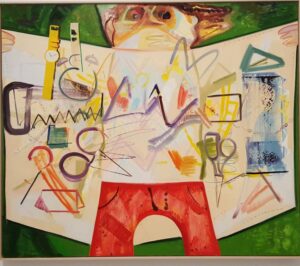
Flasher, oil on canvas, 2012.
I am consistently tempted to see the characters in Schutz’s images as actors in a play, signifiers of more fictional than real people, and two of the exhibits at the ICA show in particular pamper this impression. Flasher (2012) is unique in the sense that its style is totally different from that of the other images in the exhibition. Dominated by scribbles and smudges instead of the usual impasto and broad brushwork, the picture has a nonchalant gesture somewhat reminiscent of graffiti. Without the grotesque and the intimidating that are common to several of the other images, this is a tongue-in-cheek presentation of a hilarious pun. While a flasher is commonly a man who publicly exposes his naked body under a raincoat, this individual flashes not his genitals, but a variety of knock-offs disguised as stolen merchandise, a familiar scene on the busy streets of big cities. The second one, Building the Boat while Sailing (2012), is as large as Big Wave and Elevator, but with a very different compositional strategy. Though there are occasional diagonals and erratic marks, this painting can be examined without the anxiety demanded by the others, for it, too, has none of the physical or psychological conflicts of the other two large canvases. The pictorial planes in this image are much more stable, allowing one to traverse its complex surface with a sense of clarity.
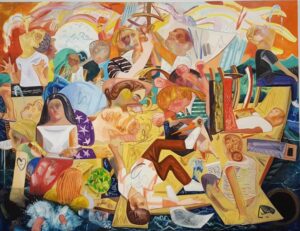
Building the Boat While Sailing, oil on canvas, 2012.
It has been acknowledged by the artist and the curators that this picture references iconic paintings by Géricault and Leutze, which makes it an allegory of art itself, alluding to boat-building as a surrogate for art-making. My observation is that while Building the Boat While Sailing allegorizes the creative and laborious sides of the production of art, the solitary figure of Flasher stands for the eccentric theatricality in Schutz’s work that I have been tracking. Locked in their allegorical roles, the crowd in the boat-building scene and the man flashing merchandise emerge, to me, as actors, their roleplaying made explicit by the artificiality of painting. It is like the Brechtian mode of theater, where the artifice of the medium is frequently foregrounded through various performative strategies in order to expose the fictionality of characters. The purpose is to dispel any illusion that what is being offered mirrors life. The non-threatening gesture of the flasher, for instance, invites one’s curiosity, only to lead one to realize that what is left to inspect are not objects, but rudimentary brush marks not meant to mimic reality. Likewise, in the larger picture, it is only by navigating the surface through the judiciously deployed color planes of reds, yellows, blues and whites that one notices each individual engaged in a task, whether working or resting. It is only then that one also discovers that except for the two men at the apex of the composition, each of the other characters exists in a bubble, playing its designated role. This roleplaying by Schutz’s characters, most often performed in disturbing yet fascinating ways, introduces one to her deep commitment to exploring the contemporary relevance of painting by staging these fictions.
Much of modernism, especially postwar American art in the heyday of the New York School in mid-century with its privileging of abstract painting, was predominantly a white male discourse. Women were marginalized at best, and artists of color were downright excluded. At least in the American scene, this privilege of abstract painting with its Romanticist claims of authenticity, originality, and authorial supremacy was challenged by the rise of Pop and Conceptualism in the 1960s. While the deconstructionist impulse of the era drew most artists of marginalized identities to performative, photo-, media-, and language-based art, the vital question about painting lingered: could painting be expected to free itself from its stasis as a medium in the conventional sense, destined to serve the myth of the solitary genius, and emerge as a discursive mode of representation that spoke for otherized subjectivities in a postindustrial society? Though the job was tough indeed, the recent years have offered a few artists who have efficiently responded to that task. Mark Bradford and Julie Mehretu are two of the brightest examples. Both Bradfrod’s and Mehretu’s work subvert late modernist determinism by recasting abstract painting in a discursive role of addressing history, economics, and urbanity. They have replaced Greenbergian self-referentiality (painting critiquing its own limits) with a more contemporary intertextuality, where images and marks relentlessly echo and replicate each other without the sanctifying touch of genius.
Compared to these two artists, both of whom use technology, engage in collaborative projects, and produce monumental paintings, Schutz’s creative enterprise is unambiguously a more traditional studio practice. What is more, unlike their focus on abstraction, Schutz has chosen figuration as the basis of her mark-making. Nonetheless, I see her as equally invested in discovering new potentials of painting. For instance, she has forged her style by taking from a variety of male-dominated movements, which is why her paintings captivate one with all the visual richness evocative of modernism: one finds references to Cubism in her planar experiments; Expressionism in her figures; Surrealism in her incongruous juxtapositions; Abstract Expressionism in her broad gestural notes on large canvases and adventurous palettes; and bold allusions to history painting. Yet they do not entrap one within the narrow confines of the appreciation of painting simply as a medium tamed by an author. While her work does not have an explicit feminist agenda, it seems Schutz’s approach to painting itself is a feminist gesture of pillaging some of the crowning male accomplishments of art history to shape her own painterly language without any qualms. This reception is categorically not a conventional case of “influence”, but one of deliberate appropriation and reinterpretation of modernist references on Schutz’s own terms. Her Building the Boat While Sailing, for instance, may bring to mind Jackson Pollock’s act of dripping paint while standing on the unstretched canvas. But Schutz unapologetically dismantles that paramount authorial image to underscore a communal enterprise –if only as a metaphor—without a dominant character in a leadership position.
This innovative textual play of painting, however, is crucially hinged on Schutz’s use of absurd theatricality, comical twists and other strategies, mediating agents that secure the distance between her painted images and reality to produce pure spectacles of fantasy. Despite its reward, this approach has its risks, for the efficacy of her images is strictly conditional upon maintaining no more than a refracted connection with life. It should be noted that the humanity one confronts in Schutz’s paintings is devoid of any clear differences of race, gender, sexuality, etc. that regularly inform life. In other words, without the mediation of the absurd interactions and the comical theatricality that tame the grotesque, the proximity of her subjects to their referents would invariably cause her paintings to lose their magic and expose themselves as inadequate signifiers of life. I believe such a slip was at the core of the controversy at Whitney, an issue my forthcoming essay on appropriation will clarify. That aside, with her quirky view of the human condition, her uncanny sense of dark humor, and her impeccable control of large canvases in translating her vision into a spectacular pictorial theater, Dana Schutz is, without question, in league with artists like Mark Bradford and Julie Mehretu in her commitment to renew painting’s relevance in the discourse of contemporary art.
Notes:
[i] See Fried, Michael, Absorption and Theatricality: Painting and Beholder in the Age of Diderot. Chicago: University of Illinois Press: 1988, c. 1980. Understandably, Fried has used theatricality to criticize American movements like Minimalism for relying too much on theatricality. See his influential essay, “Art & Objecthood”. In Art and Objecthood: Essays and Reviews. Chicago: University Press, 1998



